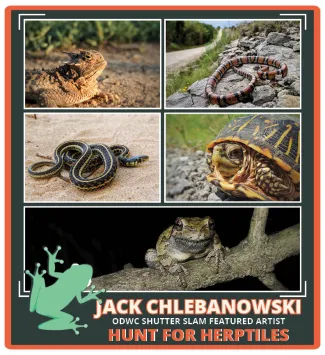Jack Chlebanowski has always had a soft spot for snakes and other reptiles – a home video shows Chlebanowski's mom handing a three-year-old Jack a small gartersnake – but his interest was mostly limited to watching, and sometimes catching, the occasional snake or lizard. That hatchling interest metamorphosed in 2020 as Chlebanowski transformed from a fan of snakes into a naturalist.

Jack Chlebanowski shared images of Oklahoma's reptile and amphibian communities in the Wildlife Department's inaugural Hunt for Herptiles Shutter Slam. Pictured are a Texas horned lizard, western milksnake, common gartersnake, plains box turtle, and gray treefrog.
When the world was waiting for the next trending hobby, Chlebanowski was exploring around his hometown of Alex, actively looking for snakes, turtles, lizards, frogs, and salamanders. Before long, his hunt for herps, the collective term for reptiles and amphibians, included photographing his finds and sharing his observations with other naturalists.
By 2021, Chlebanowski's once-every-few-weeks adventures had grown to daily 5 – 6-hour trips followed by 5 – 6-hour night cruises.
"Some days I'd flip probably 200 rocks. I wouldn't always find something under the rocks, but it really built an appreciation of the wildlife and landscape. Sometimes I'd be in a remote area and wonder if I was the first person to stand in that spot in the last 100 years."
An appreciation for nature continued to grow in Chlebanowski's temporary position in the guest services department at the Oklahoma City Zoo and Botanical Garden. He would see people getting introduced to lorikeets, feeding a giraffe, or touching a stingray, and it reminded him of his own experiences.
"I could see that same spark light up. The idea of conservation, it just clicked."
Chlebanowski, now a freshman at the University of Oklahoma, has mostly built his knowledge of Oklahoma's reptile and amphibian communities through self-learning.
"I've picked up a lot about which habitats species prefer just by going to different spots and flipping rocks or looking under logs. It can be a grind, but it's worth it."
iNaturalist, a free platform that catalogs nature sightings from citizen scientists around the world, has also helped Chlebanowski learn more about individual species, scout his next herping destination, and share his observations with other naturalists. But even with iNaturalist, and despite hours of searching and flipping rocks, he's only spotted his favorite species, the western milksnake, once.
"I've been searching for a milksnake for a few years, but so far, the one I photographed and shared in the Shutter Slam has been my one and only find.
"Their elusive nature and vibrant colors make it a thrilling species to find in the field."
As late winter temperatures rise, Chlebanowski plans to continue his search for Oklahoma's reptiles and amphibians. And he encourages others to join the search.
"It's an easy hobby to pick up – and you won't have to look far or buy a lot of new gear," Chlebanowski said. "You can start in your own backyard or local park.
"February is the start of 'frog season.' It'll be pretty easy to listen for calling frogs, like the Strecker's chorus frog, and share the observations on iNaturalist."
Listening for calling frogs or simply observing amphibians or reptiles is a great way to start your own journey as a naturalist. But attempting to catch or collecting amphibians or reptiles may require a hunting or fishing license. Get more details in the Oklahoma Hunting and Fishing Guide.